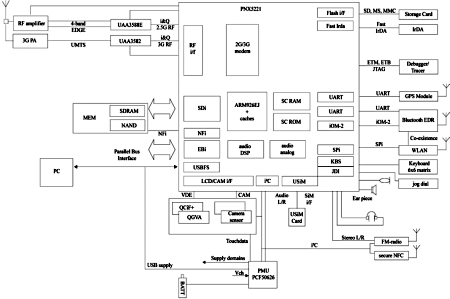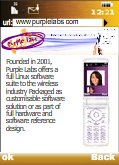Sub-$100 3G Linux phone debuts
Jan 31, 2008 — by Eric Brown — from the LinuxDevices Archive — 9 views Philips spin-off NXP Semiconductors and French mobile Linux phone stack firm Purple Labs have teamed up on a sub-$100 3G phone hardware/software reference design. The Purple Magic runs Linux and a telecom RTOS on a single ARM9 core, thanks to embedded virtualization technology.
Philips spin-off NXP Semiconductors and French mobile Linux phone stack firm Purple Labs have teamed up on a sub-$100 3G phone hardware/software reference design. The Purple Magic runs Linux and a telecom RTOS on a single ARM9 core, thanks to embedded virtualization technology.
(Click for larger view of the Purple Magic)
digg this story |
There are now 197 commercial 3G/WCDMA networks in 87 countries, according to GSA mobile industry trade group figures cited by Purple Labs. However, 3G/WCDMA networks are highly concentrated in mature European and Asian markets, a fact Purple Labs hopes its lower-cost design can change. The company is targeting Southeast Asia, Eastern Europe, and Latin America, initially.
The Purple Magic design is intended for 3G phones that could sell for $20 to $50 cheaper than current low-end models, says Purple Labs. Yet, phones based on the design could offer video telephony, music playback, WAP-based Internet browsing, streaming video, and other advanced 3G functions, according to Purple Labs.


The “Purple Magic”
(Click either view to enlarge)
Hardware design
The Purple Magic hardware/software design is based on the Nexperia Cellular System Solution 7210, a hardware reference design that NXP unveiled a year ago at the Mobile World Congress Barcelona conference. The design is built around the PNX5221, a highly integrated SoC (system-on-chip) for GSM/GPRS/EDGE/UMTS mobile handsets. Powered by a single ARM926EJ processor and a pair of 16-bit DSPs that handle image and signal processing, the SoC supports Dual Transfer Mode (DTM), offering “true UMTS” behavior independent of network type (2.5 or 3G), according to NXP.
The 7210 design also incorporates the VLX-MH VirtualLogix virtualization stack for handsets, enabling its single ARM9 core to simultaneously run Linux along with a real-time OS (RTOS) that controls the modem and voice signal processing. Virtualization was key to reducing the cost of the design, says NXP, as 3G phones typically rely on an expensive dual-microprocessor structure with multiple memory subsystems, increasing both BOM costs and power budgets.

Nexperia 7210 architecture
(Click to enlarge)
The Nexperia 7210 integrates cellular and WiFi RF modules, a single bank each of NAND and SDRAM, a power management processor, keypad, jog dial, and a memory card interface. There are also various peripheral modules, including Bluetooth radio, USB, and Near Field Communication (NFC).
Here are some basic specs for the Nexperia 7210 reference design:
- Processor — ARM926-based PNX5221 SoC with two 16-bit DSPs
- Virtualization — VirtualLogix Real-Time VLX-MH Virtualization
- Cellular protocols — GSM, GPRS, EDGE, UMTS; Class A simplified (DTM) slot class 11; GPRS/EDGE slot class 12; EDGE MCS1-9; Release 99 Modem
- Flash memory — MMC/SD/T card
- USB — OTG
- Communications — 802.11g WiFi
- Other I/O — Bluetooth 2.0+EDR; Near Field Communication (NFC); IrDA
- Multimedia — Video, video telephony, SDD audio, multi-AT channels command, streaming A/V
- Operating system — Linux Kernel v 2.6.16 with Purple Labs MMI and applications software framework
Software stack
The Purple Magic phone is based on a software stack integrated by Purple Labs. Based in Chambery, France, with a newly opened office in China, Purple Labs is said to offer “one-stop” services “from hardware reference design to a complete customizable Linux software suite.” Its published, open source Linux suite is based on a 2.4.20 kernel, with optimizations for TI OMAP730 and OMAP850 chips. However, the new design is said to be based on a Linux 2.6 kernel.






The Purple Labs feature-phone stack includes multimedia players, videoconferencing, and an HTML browser
The Purple Magic design appears to be Purple Labs's second design based on the NXP7210 hardware platform. The first was the U900, which was marketed under the Grundig brand, a mark owned or licensed by Purple Lab's former parent company, Spanish phone manufacturer Vitelcom. Purple Labs was subsequently spun out, and in September it raised $14.5 million (10.5 Euros) in an initial funding round.
Stated Simon Wilkinson, CEO of Purple Labs, “While the mobile Linux industry has largely concentrated on high-end devices, the Purple Magic is the first 3G Linux mass-market reference feature phone available today.”
Stated Dan Rabinovitsj, NXP's senior VP/GM, Cellular Business, “NXP believes in Linux as the basis for the next generation of mobile handset innovation.”
Availability
The Purple Labs Nexperia reference design is available now as a fully integrated and fully tested turnkey solution, says Purple Labs, and an NXP software developer's kit (SDK) for Linux is also available. The Purple Labs phone will be exhibited at the Mobile World Congress in Barcelona on February 11-14.
In early January, Purple Labs joined the Linux Mobile (LiMo) Foundation phone platform group. The company is also a member of a more formal standards group called the Linux Phone Standards (LiPS) Forum.
This article was originally published on LinuxDevices.com and has been donated to the open source community by QuinStreet Inc. Please visit LinuxToday.com for up-to-date news and articles about Linux and open source.